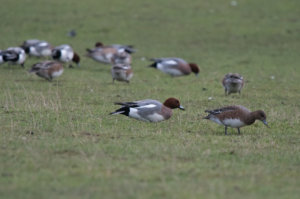 Today the RSPB revealed that wild birds with H5N8 have been detected at two more RSPB nature reserves and yesterday the Chief Vet revealed that H5N8 had been found in a small backyard flock in Settle.
Today the RSPB revealed that wild birds with H5N8 have been detected at two more RSPB nature reserves and yesterday the Chief Vet revealed that H5N8 had been found in a small backyard flock in Settle.
These wild birds with H5N8 seem almost to be targetting RSPB nature reserves! Of course, the real explanation (I guess) is that RSPB wardening staff are pretty clued up and are cooperating with Defra and sending in lots of dead birds for testing. The recent cases were a Wigeon on the Exe Estuary and a Teal at Conwy.
The locations of the wild birds are being kept rather quiet by Defra and so all credit to the RSPB for being very open. When you see that 9 Mute Swans have been found with H5N8 in Dorset one immediately wonders whether this was at the Abbotsbury Swannery. I have no idea whether it was or not but that’s where I’d go to see lots and lots of Mute Swans and it is the closest to a free-range poultry flock that you’ll find in the wild bird world.
And when you see that White-fronted Goose was one of the species affected in Gloucestershire (along with Canada Goose, Wigeon and Greylag Goose) it makes one wonder whether this was at Slimbridge. I have no idea whether it was or not but that’s where I’d go to see that species in Gloucestershire (a limited number of other locations are available).
In southwest France, very large numbers of farmed ducks (and geese?) are being killed to limit the spread of the disease in the foie gras region (see here, here and here). This quote was very interesting and you will never hear the NFU (or Defra) say anything similar in the UK:
Farmers’ union Confederation Paysanne welcomed the decision not to kill birds raised on a single site, and urged authorities to think about a reshuffle of the whole industry in order to limit the transportation of animals.
“One needs to stop turning a blind eye on this ultra-segmented industry where gigantic structures use transportation to excess, over hundreds and even thousands of kilometers,” the union said in a statement. “This is the industrialized production that causes and amplifies sanitary crises.”
The Czech Republic and Slovenia reported their first cases this week.
I’ve noticed on Twitter that quite a few people are pointing at Pheasants because of their dual status as livestock when in pens (and therefore buzzards are a ‘pest’) but wild birds when released! I did ask the Chief Vet on Twitter how many Pheasants have been tested for bird flu but he hasn’t yet replied. The Pheasant is of course the UK’s most numerous bird, is quite likely to mix with domestic poultry (all of which should be locked up now) and use similar pastures and is chased around the countryside at this time of year when shot for fun. In addition, Pheasants carcasses are occasionally dumped in the countryside. But, to be honest, I’d be surprised if Pheasants play a big part in avian fly population dynamics. Although, of course they are chased around the countryside on shooting days.
It is clear that Europe is facing a big outbreak of avian flu and that the UK is going to share in the pain.
[registration_form]
DEFRA have still not contacted several locally known, individual holdings registered as being poultry breeders. It’s as if there is no one in at the office. I know of several examples. I’m not even sure DEFRA have a comprehensive list of people to contact regarding disease.